Consumers are unerringly loyal to traditional confactionery products from big brands over the festive period. Sarsh Britton investigates
From bell ringing to carol singing, Christmas is all about tradition. This is clearly reflected in 2009's confectionery offering, which proves to be a blend of old and new.
Lindt's top-selling chocolate reindeer had best budge along the shelf as he'll have a few companions joining him this Yuletide. Last year within the novelty category, figures and shapes made a positive impact across total grocery, claims Ferrero, with sales up 6% from 2007 to 2008, and now everyone wants a piece of the action.
Thorntons is launching an assault on moulded chocolate with new launches including Santa, reindeer and penguin figurines. Nestlé is also introducing a chocolate penguin under its Smarties brand, while Ferrero has opted for a Kinder Mini Father Christmas figurine.
Ironically, it seems no one is really breaking the mould, but then Christmas is a time where consumers are looking for traditional products from trusted brands, rather than radical new product development. "Shoppers have become focused on safe brands and they're not going to waste money on something they're not sure about," explains Nestlé trade communications manager Graham Walker.
While the latest moulded chocolate offerings may all sound a bit samey, Walker explains that Nestlé's Smarties penguin will by no means be in direct competition with the likes of the Lindt reindeer because it is aimed at a totally different target market. "When you look at the foil area, the Lindt reindeer is by far the biggest seller, but that's for adults, and sales at Christmas are going more and more towards kids," he claims.
While tightened purse strings mean that consumers are cutting back on Christmas presents, parents will continue to treat their children, agrees Nestlé category development manager for Christmas, Sarah Glew. "Parents won't cut down on their kids' presents; they'll cut down on the extra presents, such as gifts for neighbours and babysitters."
A quick glance at the sales of children's favourite the giant tube seem to confirm this view. "We've had 23% value sales growth in giant tubes, and this rises to 37% within convenience," says Glew.
Walker adds: "While they are designed for Christmas, if retailers put them out in September people will still buy them earlier."
The company has gone to great efforts to ensure that its children's brands are permissible by removing any concerns parents might have about giving their children chocolate. For example, the Smarties giant tube makes a no artificial colours claim to make parents feel better about buying the product.
Nestlé is forking out half a million pounds on talking to parents about their permissible brands for children following on from the success of communicating this in various magazines last year.
The company has taken a similar approach with its selection boxes. There is a permissible range for younger kids, which includes products such as jelly tots and makes no artificial colours and flavours claims on front of pack. The other type of box is for older children and contains more chocolate products.
Cadbury has age differentiated selection boxes too. But while Nestlé's main focus is to talk to parents, Cadbury's key aim is to make its products seem magical by talking directly to children. "We took inspiration from Christmas cards to gauge which type of packaging design to use for each age group," says head of marketing for seasonal & giving, Jo Grice. "There's a simplistic cartoon for those aged five and under. For ages 6-11 we've enhanced the packaging with a hologram; and for teens there is a more sophisticated snow scene illustration."
The company has also developed a product that echoes children's excitement about the build-up to Christmas. The confectioner has developed a Magical Advent Calendar whereby the chocolates get bigger the closer kids get to Christmas, starting with a 4g chocolate and ending up with a 16g cracker. The wording on the calendar also relates to the magic and excitement surrounding the festive period by measuring each day in terms of how many nights of sleep there are until Christmas Day.
In keeping with the magic theme, Cadbury has teamed up with the Make A Wish Foundation, which grants wishes for children with life-threatening diseases. Cadbury will donate £400,000 to the charity over the next three years and the partnership will be flagged up on packs.
Meanwhile, Kraft Foods has been working on some magic of its own, revamping Toblerone and Terry's Chocolate Orange Milk with quirky seasonal designs.
The firm is also causing a stir with its Toblerone Tinys miniature bars. From September to December, any consumers who find a Golden Tiny within promotional packs can visit the Toblerone website www.toblerone.co.uk to claim one of 300 presents, which range from ASOS clothing vouchers to a luxury Christmas hamper. The brand will be supported by a £4.3m media investment a whopping 30% increase on last year.
In another bid to meet consumers' ethical values, Cadbury will also be continuing its Purple Goes Green initiative and reducing packaging. The company has made a 28% average packaging reduction on its tree decorations, and selection boxes will also continue to get smaller.
"The reduced packaging on our selection boxes and tree decorations means they help meet shoppers' ethical concerns while maintaining their seasonal appeal," says Cadbury trade communications manager Kate Harding. The company is aiming for a 25% reduction in seasonal packaging by 2010 and this Christmas is implementing an average 31.7% packaging reduction across its selection range.
Communicating the reduction to consumers will be a key focus, says Grice. "We've learnt from when Nestlé reduced its selection box packaging last year, but didn't emphasise the value for money prospect." In other words, consumers thought that smaller boxes meant less chocolate.
She also claims that Nestlé's back-of-pack design on its selection boxes was ill thought out. "Nestlé chose a strong environmental message on the back of its packs, but there was no game and it didn't work. As well as the environmental message and the Make a Wish Foundation campaign, our boxes will also include games on the back of pack to add extra value."
Nestlé's Walker is quick to respond. "There was a little bit of questioning when we made the packaging reduction to our selection boxes, but we did a lot of shelf-edge messaging, alerting consumers to the fact that they contained full-size bars," he claims.
That said, Nestlé's selection boxes have been redesigned for 2009 with a greater emphasis on bar size on front of pack. "The packs this year have the big full-size bars displayed on the front to make the message as clear as possible," says Walker.
Focusing on the environmental message and leaving out games was no mistake, either, Walker says. "Sustainability is incredibly high on the menu for young people."
His views are supported by Glew, who adds: "Games aren't massively motivational on selection boxes and when it comes to recycling, the person who has the most say in households is kids that's what they're being taught at school."
While Nestlé and Cadbury square up to one another, Mars is edging along the inside track with its own sustainability initiative. To highlight the fact that all its selection boxes, advent calendars, Maltesers boxes and tubes are now made from 100% recycled board, every pack will feature the Mars Recycle Reindeer logo. This will be accompanied by on-pack panels featuring step-by-step recycling guides.
"Christmas 2009 selection boxes and tubes will be 25% smaller than last year's, saving 788 tonnes of board and 181 tonnes of plastic," claims Mars trade relations manager Bep Sandhu. "Mars has been working in association with the government's Waste Resources Action Programme and the Seasonal Confectionery Working Group to minimise excess packaging, while refusing to compromise on the ever-important size impression and shelf standout."
Self-eat
When it comes to self-eat, the big three all have strong offerings. Nestlé saw great success with its My Favourites range, particularly in convenience stores. "The Purple One grew by 46% overall and by a massive 70% in c-stores," says Walker. "We've now got the optimum three My Favourites variants [Caramel Swirl replaced Orange Crunch last year and was deemed a resounding success].
"We made My Favourites a top priority last year, so our distribution was better and our quality of display was better, because our field reps really got behind it. This year we'll have even more of a focus on My Favourites."
Meanwhile, Mars expects Galaxy Mistletoe Kisses to continue their success as one of the top sellers in the Christmas self-eat section. "Christmas is the time when consumers seek out more indulgent brands and our research shows that they will treat themselves to a more seasonal novelty pack. The festive packaging on Galaxy Mistletoe Kisses fits perfectly with this trend," says Sandhu.
This year Mars plans to refresh the product with newly designed pre-filled units, pos material and a consumer campaign set to run throughout the season.
But there is a new kid on the block. Clear the way for Snow Bites a festive version of Easter Mini Eggs. These milk chocolate balls are coated in a crispy white dusted shell giving them the appearance of snowballs.
Cadbury has high hopes for the product. "Snowbites are projected to hit a market value of £5m, double that of Galaxy Mistletoe Kisses," says Grice. "Within the self-eat novelty section, which has seen growth up 24% year on year, there are only 12 SKUs, so there's a strong opportunity for us," she adds.
With so many different products on offer, it can be difficult to create the right range, but help is at hand.
To assist retailers to choose the best products to suit their needs, Nestlé has developed a cash and carry stand which shows its five top-selling Christmas confectionery products, and each product's profit potential (as decided by the wholesaler).
"C-stores are overtrading in seasonal impulse with a 36% share of the market. The reality is that you can only compete with the mults if you're stocking a core range of the right products," says Walker.
From bell ringing to carol singing, Christmas is all about tradition. This is clearly reflected in 2009's confectionery offering, which proves to be a blend of old and new.
Lindt's top-selling chocolate reindeer had best budge along the shelf as he'll have a few companions joining him this Yuletide. Last year within the novelty category, figures and shapes made a positive impact across total grocery, claims Ferrero, with sales up 6% from 2007 to 2008, and now everyone wants a piece of the action.
Thorntons is launching an assault on moulded chocolate with new launches including Santa, reindeer and penguin figurines. Nestlé is also introducing a chocolate penguin under its Smarties brand, while Ferrero has opted for a Kinder Mini Father Christmas figurine.
Ironically, it seems no one is really breaking the mould, but then Christmas is a time where consumers are looking for traditional products from trusted brands, rather than radical new product development. "Shoppers have become focused on safe brands and they're not going to waste money on something they're not sure about," explains Nestlé trade communications manager Graham Walker.
While the latest moulded chocolate offerings may all sound a bit samey, Walker explains that Nestlé's Smarties penguin will by no means be in direct competition with the likes of the Lindt reindeer because it is aimed at a totally different target market. "When you look at the foil area, the Lindt reindeer is by far the biggest seller, but that's for adults, and sales at Christmas are going more and more towards kids," he claims.
While tightened purse strings mean that consumers are cutting back on Christmas presents, parents will continue to treat their children, agrees Nestlé category development manager for Christmas, Sarah Glew. "Parents won't cut down on their kids' presents; they'll cut down on the extra presents, such as gifts for neighbours and babysitters."
A quick glance at the sales of children's favourite the giant tube seem to confirm this view. "We've had 23% value sales growth in giant tubes, and this rises to 37% within convenience," says Glew.
Walker adds: "While they are designed for Christmas, if retailers put them out in September people will still buy them earlier."
The company has gone to great efforts to ensure that its children's brands are permissible by removing any concerns parents might have about giving their children chocolate. For example, the Smarties giant tube makes a no artificial colours claim to make parents feel better about buying the product.
Nestlé is forking out half a million pounds on talking to parents about their permissible brands for children following on from the success of communicating this in various magazines last year.
The company has taken a similar approach with its selection boxes. There is a permissible range for younger kids, which includes products such as jelly tots and makes no artificial colours and flavours claims on front of pack. The other type of box is for older children and contains more chocolate products.
Cadbury has age differentiated selection boxes too. But while Nestlé's main focus is to talk to parents, Cadbury's key aim is to make its products seem magical by talking directly to children. "We took inspiration from Christmas cards to gauge which type of packaging design to use for each age group," says head of marketing for seasonal & giving, Jo Grice. "There's a simplistic cartoon for those aged five and under. For ages 6-11 we've enhanced the packaging with a hologram; and for teens there is a more sophisticated snow scene illustration."
The company has also developed a product that echoes children's excitement about the build-up to Christmas. The confectioner has developed a Magical Advent Calendar whereby the chocolates get bigger the closer kids get to Christmas, starting with a 4g chocolate and ending up with a 16g cracker. The wording on the calendar also relates to the magic and excitement surrounding the festive period by measuring each day in terms of how many nights of sleep there are until Christmas Day.
In keeping with the magic theme, Cadbury has teamed up with the Make A Wish Foundation, which grants wishes for children with life-threatening diseases. Cadbury will donate £400,000 to the charity over the next three years and the partnership will be flagged up on packs.
Meanwhile, Kraft Foods has been working on some magic of its own, revamping Toblerone and Terry's Chocolate Orange Milk with quirky seasonal designs.
The firm is also causing a stir with its Toblerone Tinys miniature bars. From September to December, any consumers who find a Golden Tiny within promotional packs can visit the Toblerone website www.toblerone.co.uk to claim one of 300 presents, which range from ASOS clothing vouchers to a luxury Christmas hamper. The brand will be supported by a £4.3m media investment a whopping 30% increase on last year.
In another bid to meet consumers' ethical values, Cadbury will also be continuing its Purple Goes Green initiative and reducing packaging. The company has made a 28% average packaging reduction on its tree decorations, and selection boxes will also continue to get smaller.
"The reduced packaging on our selection boxes and tree decorations means they help meet shoppers' ethical concerns while maintaining their seasonal appeal," says Cadbury trade communications manager Kate Harding. The company is aiming for a 25% reduction in seasonal packaging by 2010 and this Christmas is implementing an average 31.7% packaging reduction across its selection range.
Communicating the reduction to consumers will be a key focus, says Grice. "We've learnt from when Nestlé reduced its selection box packaging last year, but didn't emphasise the value for money prospect." In other words, consumers thought that smaller boxes meant less chocolate.
She also claims that Nestlé's back-of-pack design on its selection boxes was ill thought out. "Nestlé chose a strong environmental message on the back of its packs, but there was no game and it didn't work. As well as the environmental message and the Make a Wish Foundation campaign, our boxes will also include games on the back of pack to add extra value."
Nestlé's Walker is quick to respond. "There was a little bit of questioning when we made the packaging reduction to our selection boxes, but we did a lot of shelf-edge messaging, alerting consumers to the fact that they contained full-size bars," he claims.
That said, Nestlé's selection boxes have been redesigned for 2009 with a greater emphasis on bar size on front of pack. "The packs this year have the big full-size bars displayed on the front to make the message as clear as possible," says Walker.
Focusing on the environmental message and leaving out games was no mistake, either, Walker says. "Sustainability is incredibly high on the menu for young people."
His views are supported by Glew, who adds: "Games aren't massively motivational on selection boxes and when it comes to recycling, the person who has the most say in households is kids that's what they're being taught at school."
While Nestlé and Cadbury square up to one another, Mars is edging along the inside track with its own sustainability initiative. To highlight the fact that all its selection boxes, advent calendars, Maltesers boxes and tubes are now made from 100% recycled board, every pack will feature the Mars Recycle Reindeer logo. This will be accompanied by on-pack panels featuring step-by-step recycling guides.
"Christmas 2009 selection boxes and tubes will be 25% smaller than last year's, saving 788 tonnes of board and 181 tonnes of plastic," claims Mars trade relations manager Bep Sandhu. "Mars has been working in association with the government's Waste Resources Action Programme and the Seasonal Confectionery Working Group to minimise excess packaging, while refusing to compromise on the ever-important size impression and shelf standout."
Self-eat
When it comes to self-eat, the big three all have strong offerings. Nestlé saw great success with its My Favourites range, particularly in convenience stores. "The Purple One grew by 46% overall and by a massive 70% in c-stores," says Walker. "We've now got the optimum three My Favourites variants [Caramel Swirl replaced Orange Crunch last year and was deemed a resounding success].
"We made My Favourites a top priority last year, so our distribution was better and our quality of display was better, because our field reps really got behind it. This year we'll have even more of a focus on My Favourites."
Meanwhile, Mars expects Galaxy Mistletoe Kisses to continue their success as one of the top sellers in the Christmas self-eat section. "Christmas is the time when consumers seek out more indulgent brands and our research shows that they will treat themselves to a more seasonal novelty pack. The festive packaging on Galaxy Mistletoe Kisses fits perfectly with this trend," says Sandhu.
This year Mars plans to refresh the product with newly designed pre-filled units, pos material and a consumer campaign set to run throughout the season.
But there is a new kid on the block. Clear the way for Snow Bites a festive version of Easter Mini Eggs. These milk chocolate balls are coated in a crispy white dusted shell giving them the appearance of snowballs.
Cadbury has high hopes for the product. "Snowbites are projected to hit a market value of £5m, double that of Galaxy Mistletoe Kisses," says Grice. "Within the self-eat novelty section, which has seen growth up 24% year on year, there are only 12 SKUs, so there's a strong opportunity for us," she adds.
With so many different products on offer, it can be difficult to create the right range, but help is at hand.
To assist retailers to choose the best products to suit their needs, Nestlé has developed a cash and carry stand which shows its five top-selling Christmas confectionery products, and each product's profit potential (as decided by the wholesaler).
"C-stores are overtrading in seasonal impulse with a 36% share of the market. The reality is that you can only compete with the mults if you're stocking a core range of the right products," says Walker.


















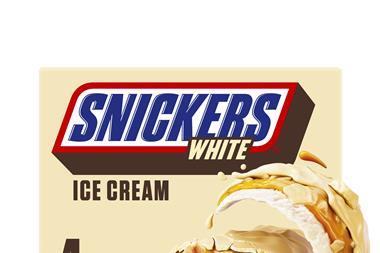
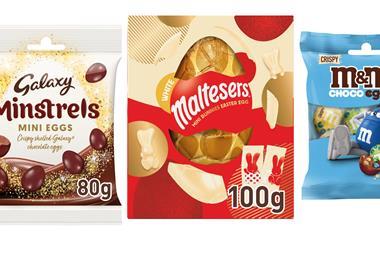
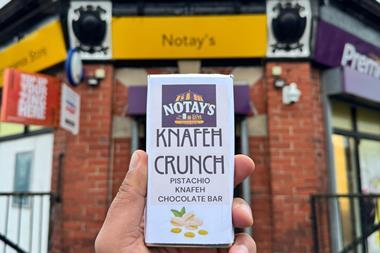

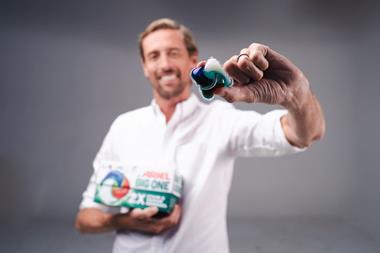



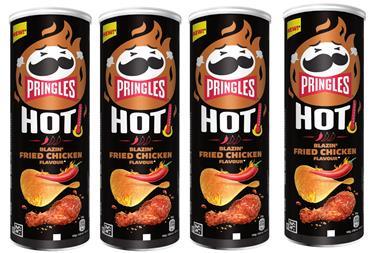

No comments yet